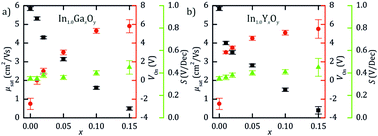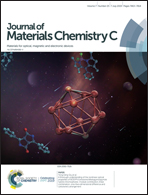Role of gallium and yttrium dopants on the stability and performance of solution processed indium oxide thin-film transistors†
Abstract
We study the effect of gallium and yttrium doping on both the electrical performance and the stability of indium based metal-oxide thin-film transistors (MOTFTs) at varied concentrations. As the Ga (Y) content in the In1.0GaxOy (In1.0YxOy) channel material was increased to x = 0.1 the mobility of the MOTFTs degrades by a factor of 4. Thereby the temperature stress stability is clearly enhanced by increasing doping concentration: the onset voltage shift is reduced by a factor of 3 for both In1.0Ga0.1Oy and In1.0Y0.1Oy films compared to that in indium-oxide TFTs. Also the stability during negative bias stress (NBS) is improved since the strong oxygen binders Ga and Y prevent the desorption of oxygen at the surface. In contrast, the onset voltage shift during positive bias stress (PBS) of doped metal oxide TFTs is higher ΔVon = 12 V for InGaO (100 : 10) TFTs and ΔVon = 15 V for InYO ((100 : 10) TFTs) compared to that of intrinsic indium oxide TFTs (ΔVon = 6 V), which could be attributed to the generation of flat trap states at the dielectric/semiconductor interface. Doping with Ga and Y significantly enhances the temperature and NBS stability of TFTs and simultaneously degrades the performance.



 Please wait while we load your content...
Please wait while we load your content...